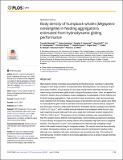Files in this item
Body density of humpback whales (Megaptera novaengliae) in feeding aggregations estimated from hydrodynamic gliding performance
Item metadata
| dc.contributor.author | Narazaki, Tomoko | |
| dc.contributor.author | Isojunno, Saana | |
| dc.contributor.author | Nowacek, Douglas P. | |
| dc.contributor.author | Swift, Rene | |
| dc.contributor.author | Friedlaender, Ari S. | |
| dc.contributor.author | Ramp, Christian | |
| dc.contributor.author | Smout, Sophie | |
| dc.contributor.author | Aoki, Kagari | |
| dc.contributor.author | Deecke, Volker B. | |
| dc.contributor.author | Sato, Katsufumi | |
| dc.contributor.author | Miller, Patrick J. O. | |
| dc.date.accessioned | 2018-07-13T10:30:07Z | |
| dc.date.available | 2018-07-13T10:30:07Z | |
| dc.date.issued | 2018-07-12 | |
| dc.identifier | 254736401 | |
| dc.identifier | 4a7b9ebc-7566-48ba-b61f-5a3fa19e02e8 | |
| dc.identifier | 85049743429 | |
| dc.identifier | 000438457400042 | |
| dc.identifier.citation | Narazaki , T , Isojunno , S , Nowacek , D P , Swift , R , Friedlaender , A S , Ramp , C , Smout , S , Aoki , K , Deecke , V B , Sato , K & Miller , P J O 2018 , ' Body density of humpback whales ( Megaptera novaengliae ) in feeding aggregations estimated from hydrodynamic gliding performance ' , PLoS ONE , vol. 13 , no. 7 , e0200287 . https://doi.org/10.1371/journal.pone.0200287 | en |
| dc.identifier.issn | 1932-6203 | |
| dc.identifier.other | RIS: urn:591E6C1FF1B8F4297D4B3E0924E34E43 | |
| dc.identifier.other | ORCID: /0000-0002-2212-2135/work/46569123 | |
| dc.identifier.uri | https://hdl.handle.net/10023/15354 | |
| dc.description | This study was funded by Strategic Environmental Research and Development Program (https://www.serdp-estcp.org; grant number RC-2337). In addition, the study was partly supported by Core Research for Evolutional Science and Technology by Japan Science and Technology Agency (http://www.jst.go.jp/kisoken/crest/en/index.html, grant number JPMJCR1685) and Bilateral Open Partnership Joint Research Projects by Japan Society for the Promotion of Science (http://www.jsps.go.jp/english/e-bilat/index.html; no specific grant number). | en |
| dc.description.abstract | Many baleen whales undertake annual fasting and feeding cycles, resulting in substantial changes in their body condition, an important factor affecting fitness. As a measure of lipid-store body condition, tissue density of a few deep diving marine mammals has been estimated using a hydrodynamic glide model of drag and buoyancy forces. Here, we applied the method to shallow-diving humpback whales (Megaptera novaeangliae) in North Atlantic and Antarctic feeding aggregations. High-resolution 3-axis acceleration, depth and speed data were collected from 24 whales. Measured values of acceleration during 5 s glides were fitted to a hydrodynamic glide model to estimate unknown parameters (tissue density, drag term and diving gas volume) in a Bayesian framework. Estimated species-average tissue density (1031.6 ± 2.1 kg m-3, ±95% credible interval) indicates that humpback whale tissue is typically negatively buoyant although there was a large inter-individual variation ranging from 1025.2 to 1043.1 kg m-3. The precision of the individual estimates was substantially finer than the variation across different individual whales, demonstrating a progressive decrease in tissue density throughout the feeding season and comparably high lipid-store in pregnant females. The drag term (CDAm-1) was estimated to be relatively high, indicating a large effect of lift-related induced drag for humpback whales. Our results show that tissue density of shallow diving baleen whales can be estimated using the hydrodynamic gliding model, although cross-validation with other techniques is an essential next step. This method for estimating body condition is likely to be broadly applicable across a range of aquatic animals and environments. | |
| dc.format.extent | 23 | |
| dc.format.extent | 3051650 | |
| dc.language.iso | eng | |
| dc.relation.ispartof | PLoS ONE | en |
| dc.subject | QH301 Biology | en |
| dc.subject | DAS | en |
| dc.subject | SDG 14 - Life Below Water | en |
| dc.subject.lcc | QH301 | en |
| dc.title | Body density of humpback whales (Megaptera novaengliae) in feeding aggregations estimated from hydrodynamic gliding performance | en |
| dc.type | Journal article | en |
| dc.contributor.institution | University of St Andrews. Sea Mammal Research Unit | en |
| dc.contributor.institution | University of St Andrews. School of Biology | en |
| dc.contributor.institution | University of St Andrews. Scottish Oceans Institute | en |
| dc.contributor.institution | University of St Andrews. Centre for Research into Ecological & Environmental Modelling | en |
| dc.contributor.institution | University of St Andrews. Marine Alliance for Science & Technology Scotland | en |
| dc.contributor.institution | University of St Andrews. Institute of Behavioural and Neural Sciences | en |
| dc.contributor.institution | University of St Andrews. Centre for Social Learning & Cognitive Evolution | en |
| dc.contributor.institution | University of St Andrews. Bioacoustics group | en |
| dc.identifier.doi | 10.1371/journal.pone.0200287 | |
| dc.description.status | Peer reviewed | en |
This item appears in the following Collection(s)
Items in the St Andrews Research Repository are protected by copyright, with all rights reserved, unless otherwise indicated.

